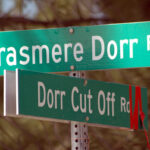Home »

Peering into a Tangle of Time
By Anne Jardine
Windermere author Maureen Thorpe grew up in Yorkshire, England. She moved to Canada as a young woman and worked as a nurse for many years.
 Since retiring from medicine, she has embarked on a new career as a writer of historical fiction. Her first novel, Tangle of Time, published by Ekstasis Editions, is a coming-of-age-time-travel-fantasy-mystery set in Yorkshire in modern and medieval times.
Since retiring from medicine, she has embarked on a new career as a writer of historical fiction. Her first novel, Tangle of Time, published by Ekstasis Editions, is a coming-of-age-time-travel-fantasy-mystery set in Yorkshire in modern and medieval times.
Like the author, the novel’s main character Annie Thornton also has a career in health care – she’s a midwife. Annie is a modern 21st Century Yorkshire lass with an intriguing legacy of witchcraft, connected to an ancient Book of Spells disdainfully passed on to her by her mother as “the family curse,” and a wonderfully empathetic inky black cat named Rosamund.
Annie is drawn to the poetic, mysterious heirloom book. She tries her first experiment with magic in an effort to help her best friend Mary who wants to be a writer but struggles with how to begin.
Whilst stirring up the ingredients for “A Scribe’s Enhancement,” Annie tumbles into a time shift and lands in front of the cottage of her great…great… Aunt Meg from 600 years ago. Unconscious and guarded by her anxious cat, Annie is discovered by Will and Jack, two battle weary young soldiers returning to York from a posting in France. They revive her and settle her comfortably in the cottage, then retire to sleep in the shed, so as not to compromise her virtue.
Annie must hide her confusion and figure out the circumstances into which she has fallen. Mistress Davey, a friend of Aunt Meg, helpfully welcomes her with the news that her aunt has left instructions that she is to take up her aunt’s duties as village midwife and nurse until such time as her aunt can return from a short journey.
With her medical training and her aunt’s extensive collection of herbs, Annie is easily able to attend to the childbirths and other health needs of the village. She is also able to begin developing her skills with spells and potions.
The returning soldiers, Jack and Will, want to settle in this village, and so begin to make enquiries about buying a local inn that has recently been abandoned. Romance begins to bloom between Annie and tall, handsome Will.
Almost immediately the local authorities take an interest in the newcomers. The village reeve, the priest, and the regional steward along with his bailiff and bullyboy constabulary, suspect that Annie, Jack, and Will are a threat to the smuggling trade that has thrived there for many years.
Aunt Meg eventually returns from her travels with her cat Bea. Annie’s cat Rosamund is hostile at first, but soon becomes an ally as Aunt Meg’s role takes on new significance. Mysterious disappearances, deaths, midnight journeys, and an ugly abduction fill the story with suspense. Corruption and cover-ups abound.
 Meanwhile, back in the 21st Century, Annie’s friend Mary has been worried about Annie’s disappearance, but has found her inspiration and has begun writing. The protagonist of Mary’s novel is her friend Annie and the story that is unfolding in the 15th Century. Mary becomes obsessed with her writing project and feels desperately responsible for the fate of the characters of the story.
Meanwhile, back in the 21st Century, Annie’s friend Mary has been worried about Annie’s disappearance, but has found her inspiration and has begun writing. The protagonist of Mary’s novel is her friend Annie and the story that is unfolding in the 15th Century. Mary becomes obsessed with her writing project and feels desperately responsible for the fate of the characters of the story.
Maureen Thorpe weaves all these stands into a leap-frogging romp through time that eventually leads to the resolution of the ancient mysteries and Annie’s return to the 21st Century. Thorpe’s explanation of how she developed the idea for this novel is almost as mysterious as Mary’s sudden compulsion to write.
She belongs to a writers’ group that hosted a workshop and retreat in Florida a few years back. Flying home from that writing camp, Thorpe became very ill. “I woke from a fevered sleep with the complete story in my head: the concept, the characters, the setting, everything,” she said. “My first working title for the book was The Story that Wrote Itself.
“I knew about Yorkshire and the landscape, and I knew about nursing. I didn’t know anything about witchcraft, but I used to enjoy the TV series Bewitched back in the 1960s and ‘70s, and I have always been fascinated in the notion that a normal, ordinary person can have special powers.
“As part of my research, I visited the Museum of Witchcraft & Magic in the south of England. It was full of artifacts and books related to witchcraft. Some of it was creepy, but one sign really resonated for me: it said, ‘Do No Harm.’
I wanted my characters to be guided by that principle. Their spells and charms would be used for helping rather than hurting people. And of course this connects to medicines and remedies too. There may have been evil witches, but the ones I want to write about are the ones who understood the powers of nature and the natural world and used those powers for the good. They were referred to as wise women, or sometimes, wild women.
“The biggest part of my research, though, had to do with the time period. What did people eat and drink? What did they wear? What did they do for fun? How did they move around the environment? I know they didn’t move very far, apart from the sailors, of course. Most people never ventured further than a few miles from their village. Even in my grandparent’s time in Yorkshire, the speech patterns and dialects from one community could be almost unintelligible to people of another community only six or seven miles away. Of course, this must have contributed to a suspicion of strangers. I studied old maps, searched for menus and recipes from the old inns. I learned about the wool trade, the rites and rituals of the church, the farming methods. To tell a story convincingly, you need to know lots of specific details. I think I’m kind of a natural researcher.”
As to how she put all those details together to create a book, Thorpe said, “I’ve been an avid reader all my life, so I developed a sense of pacing and plotting, and I’ve always been kind of known as a story teller. But there is definitely the practical side of my nature. I think it’s a Yorkshire trait. Get right down to things. Don’t waste time. Go from A to B. Tell the story. But that’s not how writing works! I’m not sure who said it first, but there is a saying: ‘There’s no such thing as good writing, only good rewriting.’
“At first I was impatient about this, but then as I rewrote and rewrote, I began to see that those research details all had a place, and my characters all had specific reactions, feelings, sensory responses. Is it raining? What does that smell like? Is the wind blowing? Is the fog rolling in? Some of those particulars deserve to be included so that the story can be real.”
For her presentations at the Invermere and Radium libraries, Thorpe read passages from her book aloud and recounted her experiences as a first time novelist, explaining that the story of Annie and Rosamund will become a series with at least two more volumes in the works.
She brought along gingerbread and shortbread made from medieval recipes and a lap-top slide show of scenes of village life in England to help set the mood. She sold and signed many books. Even without her sharp, peppery gingerbread, though, Tangle of Time will be a perfect holiday gift for the constant readers in any family.
e-KNOW







